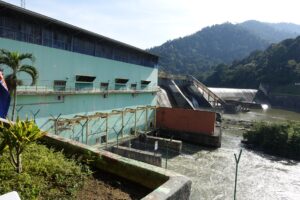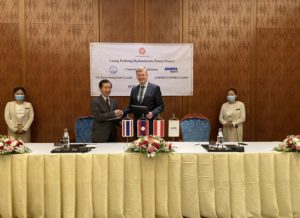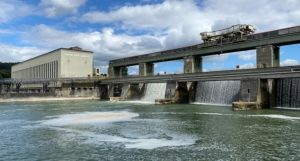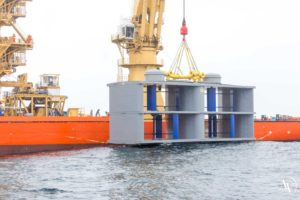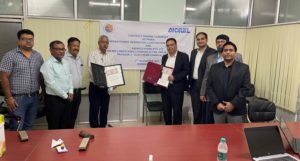New KSB Impeller Combines Reliability and Efficiency
Against a back ground of growing demands from the water and wastewater treatment industries for submersible motor pumps that resist clogging, deliver reliability and contribute to improving energy efficiency, KSB AG has developed a new centrifugal pump, the Amarex-KRT F-Max that addresses these issues.
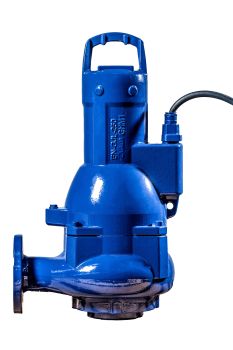
The new Amarex KRT F-Max (Image: KSB)
Improved hydraulic system and motor performance are delivered through the design of a new vortex impeller and a motor that offers efficiencies currently calculated according to the same IEC 60034-2 measurement method as that used for motors of dry-installed pumps.
In order to attain a pump’s optimum operating point, it is essential to select the correct impeller and size of impeller for the application. Whilst free-flow or ‘open’ impellers enable suspended solids in wastewater to pass more easily through the pump than closed single channel or multi-channel impellers, they do not compare favourably when it comes to performance. It is for these reasons that KSB has focused on designing an open impeller that can achieve and even exceed the efficiency levels associated with single-channel impellers.
To improve overall efficiency, KSB has looked optimise the motors efficiency in anticipation of future standards and market requirements is in compliance with IE3.This has enabled KSB to markedly reduce energy consumption.
Impeller Development
The concept behind the design of the new pump is the elimination clogging, a problem that causes inefficient flows and possibly subsequent pump failure through the presence of solids in wastewater. According to KSB the first stage in finding a solution to clogging was to differentiate between rigid and non-rigid solids. Michael Lebkuecher, who headed the product management solid burden pumps, comments: “Rigid solids need to have sufficient space in the pump chamber for them to pass through the pump. When it comes to non-rigid solids we have to ensure that the presence of wet tissues and similar fibrous materials do not form a mass. These problems were resolved, but then the next challenge was to address overall efficiency.”
Fibrous materials, such as hygienic wipes, have become a major problem in waste water transport as their use has markedly increased in the last few years. As a result of the trend towards conserving drinking water and separating stormwater and waste water, the waste water to be handled has become ‘thicker’. This is why operators now demand non-clogging impellers that offer reliable operation without sacrificing high efficiencies, even for small waste water pumps.
Based on decades of experience in free-flow impeller design, KSB’s hydraulic experts employed Computational Fluid Dynamics (CFD) to gain detailed knowledge about the complex flow processes inside the pump via computer-aided simulations. The F-Max Impeller combines outstanding hydraulics efficiency in a vortex impeller with the free passage of rigid and non-rigid solids through the pump. The six vanes on the surface of the vortex impeller are spaced at irregular intervals (Fig.2)that creates gaps which allow rigid solids to pass through the impeller, even when the impellers is close to the suction cover.
Machining grooves into the surface of the reverse side of the impeller spread out from the centre balances the axial thrust. Making a groove rather than a vane means that the impeller can be moved closer to the suction cover, thereby minimising the gap
Having resolved the issue with rigid solids, KSB’s designers turned their attention to that of soft tissues and similar fibrous materials. Blockages involving soft materials start at the hub or ‘eye’ of the impeller and there is a physical reason for this. The revolving motion of the impeller introduces velocity and the greater the distance from the centre of the impeller is where the velocity is greatest. If there is material at the centre of the impeller, there is insufficient speed to eject the material which means that a swirl has to be created to remove the material. The swirl comes from the radius and shape inside the impeller vanes and this swirl is three-dimensional and it is this which moves the materials through the system.
The F-Max achieves a highly effective swirl motion through a slight convex profile at the hub of the impeller, achieving efficiencies that have previously only been reached by single-channel impellers. When rotating, the impeller creates a strong swirl keeps solids in suspension significantly reduces the risk of clogging (Fig.3). Since the radial forces and vibrations created by the new impeller are usually lower than those of single-channel impellers, the service life of shaft seals and rolling element bearings is increased. Pumps with F-max impellers thus require only minimal maintenance. Replacing the impeller itself is also straightforward.
New motor IE3
The ErP directive on motor efficiency only applies to motors of dry-installed pumps, not for submersible motor pumps. In the absence of a standard for submersible pumps KSB has developed its new motor using calculations currently calculated according to the same IEC 60034-2 measurement method as used for motors of dry-installed pumps. It is for this reason that the Amarex KRT F-Max pump is described by KSB as being ‘in compliance with IE3’, in anticipation of future standards and market requirements.
When it comes to calculating the motor efficiency of a submersible pump, every manufacturer applies its own methods, with some accounting for the internal losses in the hydraulic system or in the motor s efficiency. The losses of the individual components (motor, pump) occurring on a dry-installed pump can be clearly identified, whereas this is not so obvious on a submersible motor pump. In designing its new motor KSB looked at the overall efficiency, i.e. the efficiency of both pump and motor.
KSB s new IE3-like energy-saving motors – which take mechanical losses into account – benefit from a number of important technical improvements, the key ones being improved aluminium rotors and materials and improved motor windings. By optimising the rotor, it has been possible to reduce the heat generated in the stator windings, rolling element bearings and rotor cage, the magnetic losses in the stator core, the friction losses incurred in the bearings, the operating temperatures of all motor parts and the electrical resistance in the motor windings and the rotor cage. This has resulted in a reduction of current consumption and an increase in service life of both the insulation material and the bearing grease.
Optimising the motor winding has had the positive effects of reducing magnetic flux losses and thus reduced magnetic losses, increasing power factor (cos phi)and therefore reduced rated current, and limiting the starting current ratio (Id/in) to very low values (< 8 compared with 10, customary in the market, hence a reduction by 20%).
Summary
The Amarex KRT F-Max offers the capabilities to handle wastewater, river water, stormwater, municipal waste water, sludges, industrial waste water, seawater and brackish water. In order to accommodate this extensive range impellers are available in cast iron, stainless and acid-resistant duplex steel. The pump has the capability to deliver flow rates of up to 130m³/h and heads up to 60m.
Manufacturing is now underway at KSB’s factories in Lille, France and Halle, Germany and plans are in place to extend manufacturing to its operations in India, China and Brazil thereby ensuring this new pump is available on a global basis.
Source: KSB SE & Co. KGaA

